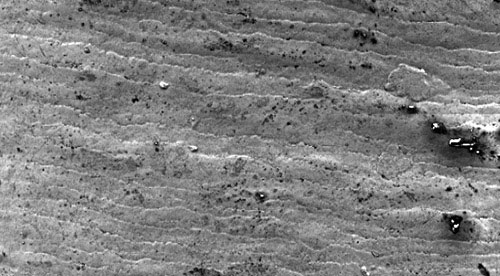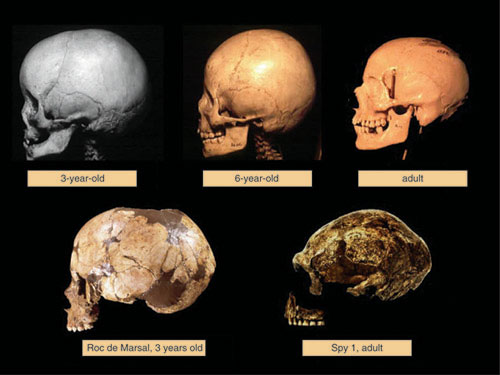Growing up Neandertal
By Pat Lee Shipman
Studies of fossils show that Neandertals matured differently and more quickly than humans
Studies of fossils show that Neandertals matured differently and more quickly than humans

DOI: 10.1511/2004.50.506
They were not us. That is, Neandertals were probably not members of our own species, judging from recent analyses of mitochondrial DNA (described in the November-December 2003 issue). Nonetheless, Neandertals were clearly built on a human-like plan (or vice versa) with some crucial modifications.

Photomicrograph courtesy of Debbie Guatelli-Steinberg, Ohio State University.
A glance at the fossil remains of these hominids shows that Neandertal bones are much more robust than those of modern Homo sapiens. The skulls of the two species also show several striking differences. One of the most noticeable Neandertal features is the unmistakably large, bony browridges that stick out over the eyes. Below the orbits, the face is more prognathic—the nose and jaw protrude farther in front of the braincase—than a human face. The prominent nasal bones in Neandertal skulls top wide nasal openings, suggesting that they sported large, aquiline noses. Unlike the smoother, rounded contour of the human skull, the back of the Neandertal skull has a distinctive bulge, often referred to as a chignon or bun. Overall, the Neandertal skull resembles what you might expect if someone took a human skull made of rubber, grabbed it by the face and back of the head, and pulled.
These comparisons attracted the attention of scientists who study the interactions between evolution and development from birth to adulthood—so-called "evo-devo." Put simply, they wanted to know: How do you grow up Neandertal?
In the spring of 2004, several studies offered fascinating answers to this question. Fernando Ramírez Rozzi of the Centre national de la recherche scientifique in Paris and José Maria Bermúdez de Castro of the Museo Nacional de Ciencias Naturales in Madrid compared the rates of dental growth in several species within the genus Homo, including Neandertals. They examined the perikymata—small enamel ridges on the tooth surface—of incisor and canine teeth from 55 Neandertals, 25 Homo antecessor and Homo heidelbergensis individuals (two species that some anthropologists group together) and 39 ancient but anatomically modern humans.
Perikymata are created as a tooth grows. In humans and their close kin (such as Homo erectus), one ridge is created approximately every nine days during tooth development. The ridges of more distant relatives, including chimpanzees and gorillas, are formed at shorter intervals. By counting the number of perikymata, investigators can calculate how long the tooth took to form.
Surprisingly—and this is also the first word in the title of their paper— Ramírez Rozzi and Bermúdez de Castro found that Neandertals formed their teeth in fewer days than did H. antecessor and H. heidelbergensis. If Neandertals had been the most ancient of the lot, one might expect them to be the most ape-like. But although the other fossil species are older still, they already show the human pattern. The finding is also a surprise because some scientists still feel that Neandertals are, basically, just funny-looking humans—a judgment challenged by this fundamental difference.
Dental maturity is a common proxy for overall maturity because neurological, skeletal and sexual milestones are correlated with the pace of tooth mineralization. The authors concluded that faster dental development meant that Neandertals reached adulthood 15 percent sooner than humans, on average. To state this finding in practical terms, if humans attain physical maturity at 18 years, Neandertals were similarly grown at 15 years.
Their paper also examined the spacing of perikymata across the front surfaces of incisors and canines. Dental enamel forms first at the tip of the crown—the first point to emerge from the gum—and then proceeds toward the roots. In modern humans, the perikymata are widely spaced in the half of the tooth that formed first, indicating that lots of enamel was deposited during each nine-day increment. On the second half of each human tooth, the ridges are more closely spaced, showing a slower daily rate of enamel formation.
Like human teeth, Neandertal teeth look as if they grew rapidly at first and then slowed down. However, on the part of each Neandertal tooth that grew later, the perikymata are more spread out than in their human counterparts. In other words, although the rate of enamel formation also decreased with age in Neandertals, the slowdown was less pronounced. This pattern of dental growth resembles that of apes. We know that the apes of today reach physical maturity much faster than humans. So, presumably, did Neandertals.
Ramírez Rozzi and Bermúdez de Castro speculated that Neandertals evolved a more rapid rate of physical maturation in response to high mortality rates. Erik Trinkaus of Washington University in St. Louis documented this subject in 1995 using the remains of 206 Neandertals whose age at death could be estimated from dental or skeletal indicators.
Astonishingly, Trinkaus found that the great majority (80 percent) of these individuals died before reaching middle age (defined as the equivalent of 40 human years). The largest fraction (40 percent) died during early adulthood—equivalent to a human age between 20 and 40 years. Even the famous "Old Man of La Chapelle-aux-Saints"—whose remains indicate that he suffered from degenerative joint disease and tooth loss during life—died around age 30. If, as these data suggest, Neandertals usually died young, then natural selection would favor individuals who grew up fast and bore their babies early. Also, earlier maturity among their offspring would shorten the period of vulnerable childhood—another selective advantage.
Growing up Neandertal was apparently a sprint compared with the endurance contest of human growth, and the fossil record shows that the finish lines, and perhaps the racecourses, were different for the two species. But how exactly did these paths diverge? Just what had to be accomplished during Neandertals' childhood years?
Certainly, the crania of both species had to grow during the course of development, although the adult skulls of Neandertals and modern humans are quite different. Perhaps Neandertals were born with skulls much like those of modern humans, but these skulls grew differently—earlier, faster or longer—to produce the distinctive shape of an adult Neandertal skull. Were this hypothesis true, it might suggest that modern humans descended from Neandertal ancestors by mutations that altered the timing or duration of cranial growth. For example, hulking Neandertal browridges might have evolved into the more modest browridges of modern, adult humans through slower growth of that region. In that case, an adult human would resemble an immature Neandertal, a condition called neoteny.

Frank L'Engle Williams of Georgia State University and Laurie Godfrey and Mike Sutherland of the University of Massachusetts described a test of the hypothesis that humans resembled neotenous Neandertals in a chapter of the recent book Patterns of Growth and Development in the Genus Homo (Cambridge University Press, 2003). The team measured 24 linear features on skulls from 41 Neandertals and 294 modern humans that represented every stage of the life cycle. They programmed these data into a computer model that tried to simulate the "evolution" of modern humans from adult or juvenile Neandertals by varying the rate of change for shape, size or a combination of both.
The attempt failed. Although Neandertal skulls are larger in all dimensions than human ones, simply making a Neandertal skull smaller does not produce something that looks like an adult human skull. The differences lie deeper than mere size. Using juvenile or immature Neandertals as a starting point worked no better: Adult human skulls were as different from those of immature Neandertals as the human specimens were from mature fossils. The authors' conclusion was that "humans make poor neotenous Neandertals," according to Williams.
If neoteny cannot explain the differences between human and Neandertal skulls, two possibilities remain: Either Neandertal newborns started with a different template and then grew like humans, or they started differently and grew differently as well.
Gail Krovitz of the University of Colorado at Denver addressed these competing hypotheses in a contribution to the same book (which she also helped edit). Unable to follow living Neandertals as they grew, she instead used a cross-sectional sample of Neandertal and human remains divided into five age classes on the basis of dental maturity, using human standards: 0-3 years; 3-6 years; 6-9 years; 9-13.5 years and greater than 13.5 years.
In this study, Krovitz recorded the three-dimensional coordinates of 39 anatomical landmarks on the crania of 5 immature and 18 adult Neandertals. The small sample size reflects the scarcity of the accessible, virtually complete specimens that are needed for this kind of study. Krovitz also took similar measurements on 230 immature and 142 adult human crania. After calculating averages for the landmark positions within each age class, she analyzed the distance increase between all possible pairs of landmarks in successive age classes. This procedure revealed the developmental stage and extent of cranial growth, by region, for each species.
In fact, there was scant variation over time in the well-known differences between Neandertal and human crania—the same distinctions held true across the board. In every age group, Neandertal fossils were longer in the lower face, wider across the orbits, longer front to back, and lower from the top of the braincase to the cranial base than human specimens, implying that some or all of the distinguishing features of Neandertal crania formed prior to birth. Yet in the midst of this uniformity, the patterns of growth were different. In general, between birth and age 9, Neandertal faces grew longer below the browridges and became more prognathic, while human faces widened across the orbits. From 9 to 13.5 years, Neandertal faces broadened across the orbits and elongated below the nasal aperture. In humans, the entire face lengthened. After 13.5 years of age, Neandertal crania continued to elongate and widen more than human crania, further increasing their prognathism.
These dissimilarities in growth are statistically significant and Krovitz believes they reflect a fundamentally different developmental pattern acting upon a different cranial shape found at or perhaps before birth. "Neandertals were born as baby Neandertals," she explains, "and throughout their life, the shape differences in their heads were accentuated by different patterns of growth."
Analyzing growth and development in fossil species is fraught with subtle pitfalls and plagued by small sample sizes. Yet independent analyses of dental and skeletal markers tell the same story, one of rapid growth and a nonhuman pattern of shape change throughout Neandertal childhood. If Neandertals were not "us" genetically, as most paleoanthropologists now believe, neither were they "us" in terms of development. Perhaps a suitable epitaph for Neandertals is this:
Thickened, heavy skulls long gone,
They grew up strange, lived fast, died young.
Click "American Scientist" to access home page
American Scientist Comments and Discussion
To discuss our articles or comment on them, please share them and tag American Scientist on social media platforms. Here are links to our profiles on Twitter, Facebook, and LinkedIn.
If we re-share your post, we will moderate comments/discussion following our comments policy.